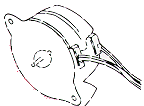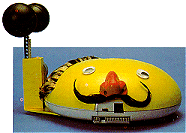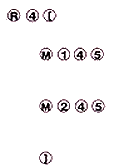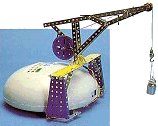
|
Feedback Form

ROAMER CONTROL:
OPERATING STEPPER MOTORS

Marcus Topham, Senior IT Development Officer with Bradford LEA, continues his look at the Roamer's Control features.
Stepper Motors are one of the most useful devices used ir commercial control technology. Yet because of the complexity of operating them they are not used extensively in technology teaching. Most of the control boxes currently available require an additional stepper motor driver unit and some complex programming of several outputs to make the motor work.
This is not the case with the Roamer, which helps make the stepper motor much more accessible to young pupils. Simply tell the motor in which direction to turn and the number of steps it should turn.
To program the stepper motor, press  followed by
followed by  to turn
it clockwise and
to turn
it clockwise and  to
turn it anti-clockwise (see "GO" issue 2 for convention on turn direction).
Then enter a number (1-999) to tell the motor how many steps to turn in
that direction.
to
turn it anti-clockwise (see "GO" issue 2 for convention on turn direction).
Then enter a number (1-999) to tell the motor how many steps to turn in
that direction.
The Roamer cannot move, turn or make a sound while it is using the stepper motor. However, the state of an output is not changed by using the stepper motor. For example, a light will stay lit while the motor is used.
 Stepper Motors Stepper MotorsThe stepper motor is used extensively in situations that require precise movements - e.g. computer printers. Stepper motors turn in either clockwise or anticlockwise directions in steps, usually of 7.5°. This means that, unlike DC motors, they can be turned a precise amount. DC motors are driven by a continuous direct current. Stepper motors are driven by pulses of current. Each pulse turns the motor one step. For example, a motor told to turn through 100 steps will travel 750°. The stepping rate is usually so fast that the rotation appears smooth and continuous. The Valiant stepper motor comes ready-wired to a connector suitable for the control box. If you use another type of stepper motor with the control box, it should be wired up by a technician. |
Stepper Motor Brake When a stepper motor is not turning, a braking
force holds it in place. When the braking effect is not needed, it is
important to turn the power to the motor off. This conserves battery power.
To turn the power off, press  without any numbers.
without any numbers.


Strong Man
Biceps raises and lowers the dumb-bell, which is made from two balls of
foam on a lightweight rod. The lift/lower mechanism is a rack and pinion
driven directly by a 12V 7.5° stepper motor. The dumb-bell's linear movement
corresponds exactly with the precise movement of the motor.
GO PROGRAM

| Repeat the following instructions 4 times. The stepper motor is switched on and turns 45 steps clockwise. Biceps lifts the dumb-bell. The stepper motor turns 45 steps anti-clockwise. Biceps lowers the dumb-bell. |


Crane
The Meccano crane uses a stepper motor to drive the hoist mechanism. The
motor's braking effect enables the load to be held in a raised position.
GO PROGRAM

| Raise load Turn Roamer to the right. Stepper motor power is still on and acts as a brake, which holds the load suspended. |
| Back |
|---|